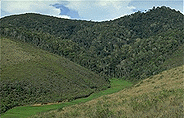
Remnant High Plateau forest providing constant source of water for rice paddies east of Anjozorobe
Support for this interpretation comes from several places in Africa. Chapman and White (1970) studied vegetation on the Vipya Plateau in Malawi, at a latitude and elevation comparable to central Madagascar, with a remarkably similar climate, length of dry season, and generic composition of the forests. They provide clear evidence that frequent burning can result in the replacement of luxuriant evergreen forest with secondary grassland in less than 500 years without any forest cutting. Stumps of Ocotea usambarensis, a tree that grows only in dense forest, are documented several km from the forest edge, two of which are dated around 350 years of age. In another study, Trapnell (1959) examined the ecological results of woodland burning experiments at Ndola in Zimbabwe, a station located at 13 degrees S latitude and 1200 m in elevation. Twenty three years of study using several controlled burning regimes clearly showed that Brachystegia - Julbernardia woodland, which also contains many elements common with the drier woodlands on Madagascar, can be totally destroyed by regular late-season burning, precisely the type of burning regime practiced in Madagascar.
This can be inferred from the current distribution of certain plant groups. For example, Hildegardia erythrosiphon is an important tree in the deciduous forests of the west.
The genus is also represented in the heart of the wet forests of the east by Hildegardia perrieri, which stands out remarkably by being one of the extremely few deciduous species in otherwise completely evergreen forest.
Similarly, Phyllarthron, a genus of Bignoniaceae endemic to Madagascar, has about a dozen species, all of which have phyllodes -- the modified petiole/rachis of a compound leaf that has lost its leaflets -- that function like leaf blades. These phyllodes are clearly adaptations to dry environments. Phyllarthron berniereanum occurs in the extremely dry south, where one would expect to see it. But a number of other species (e.g., P. articulatum, P. cauliflorum, and P. antongiliensis), all of which have these distinctive phyllodes, are found in some of the country's wettest forests.